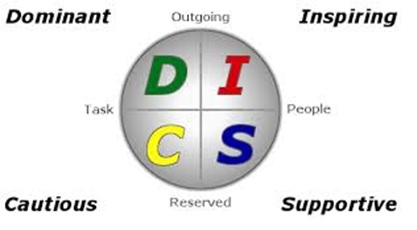
If you’re a high I, here’s how you relate…
…to a high D:
People with the D style like to get right to the point. They’re probably straightforward and even blunt at times, while you’re more likely to spend time building friendly relationships rather than focusing quickly on the bottom line. As a result, they may become frustrated if you spend too much time socializing, and you may sometimes take their frankness personally.
Strategies:
- When trying to connect, minimize small talk, and dig right into business.
- Avoid taking it personally when they ignore efforts to be friendly and go directly to topics at hand.
- Show them how your people-focused approach can bring bottom-line results.
- When solving problems, avoid emphasizing other people’s feelings at the expense of finding workable answers.
- Refrain from suggesting unrealistically positive scenarios
- Take time to consider whether your speedy decisions might cause more problems in the future.
- If things get tense, don’t brush problems under the rug just to keep things friendly.
- Avoid interpreting their directness as a personal attack.
- State your points objectively rather than lashing out emotionally.
…to another I style:
People with the ‘I’ style thrive in high-energy settings where they can work collaboratively on exciting projects. They’ll likely share your lively approach. Discussions between you may be friendly and sociable, but you may stray off topic. Furthermore, the two of you may skip important details, in your eagerness to move quickly.
- When trying to connect, join them in looking for fun, collaborative projects.
- Enjoy the social aspects of your work, but keep each other focused on the task at hand when necessary.
- Work together to make sure that you’re considering both the big picture and the details.
- When solving problems, capitalize on your shared energy, but take time to consider the pros and cons.
- Share your exciting ideas with them.
- Balance your spontaneous approach with a clear look at your solution’s potential consequences.
- When things get tense, avoid personal attacks, and stick to the topic at hand.
- Express a desire to work through the conflict quickly but thoroughly.
- Let them know that a disagreement now doesn’t mean a poor relationship down the road.
…with the S style:
People with S style value cooperation and friendly interaction. Like them, you also prioritize collaboration and getting everyone involved. However, you tend to be much more expressive than they are, and you may end up inadvertently monopolizing conversations with them. And, while they probably appreciate your cheerful, spirited approach, your high energy may be a little overwhelming for them at times.
- When trying to connect, use your upbeat approach to encourage them to share their ideas.
- Avoid pushing them beyond their comfort zone toward your adventurous plans.
- Work collaboratively with them, but avoid overwhelming them with your energy and chattiness.
- When problems need to be solved, keep in mind that their more cautious approach may be a good counterbalance to your spontaneity.
- Encourage them to share their concerns about risky opinions since they can be hesitant to speak up.
- Weight the evidence carefully before jumping on new ideas.
- When things get tense, express your concerns for their feelings and show a desire to work through conflict quickly and calmly.
- Address the situation directly right from the start rather than masking your differences.
- Follow up to make sure the issue is resolved.
…with a C:
People with the C style would rather focus on facts than feelings. They may sometimes think your friendliness infringes on their personal space and interrupts their work. In addition, your enthusiastic acceptance of new people and ideas, which is typical of your I style, may be at odds with their more cautious, analytical approach. They may be uncomfortable with your spontaneity.
- When trying to connect, skip the small talk and keep the discussion focused on the task at hand.
- Let them set the pace rather than expecting them to reciprocate your lively approach.
- Stick to the facts rather than trying to use enthusiasm to influence them.
- When problems need to be solved, reinforce the need for urgency if they appear bogged down, but remember that their careful analysis may lead to new opportunities.
- Back up your arguments with hard data rather than energy and enthusiasm.
- Strike a balance between your more optimistic approach and their more skeptical ones.
- When things get tense, don’t insist on an immediate resolution, since they may need time to process the situation.
- State your position factually and objectively and give them time to present their side.
- Avoid emotional displays since this makes them uncomfortable and more likely to retreat.
Prompts/Pre-frames to use with a High I personality style:
“I am not resisting change, change is difficult for me and takes me time to process, bear with me, help me to understand, adapt and process so I can be on board with the change.”
“I know you like change and are excited about change, change is more difficult for me, please be patient and help me to understand.”
“You are more people focused and I am more task focused, let’s talk about both to better understand each other’s priorities.”
“You have so much energy, sometimes it is overwhelming, how can I communicate that to you when that happens?”
“I know you enjoy doing many things at once, however, we have a project due next week and it needs your attention, how can I help you make that happen?”
“You have some great ideas, I am the kind of person who likes to make sure the systems and processes are in order, so, let’s work together to make sure all the pieces are in place to make insure the idea/project is successful.”
“I want to make sure we are on target for the due date of project X.”


